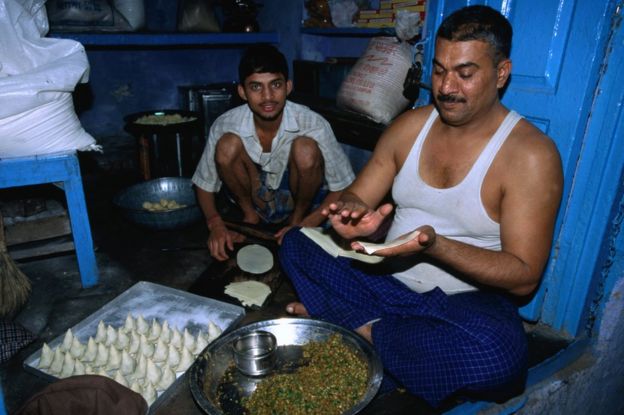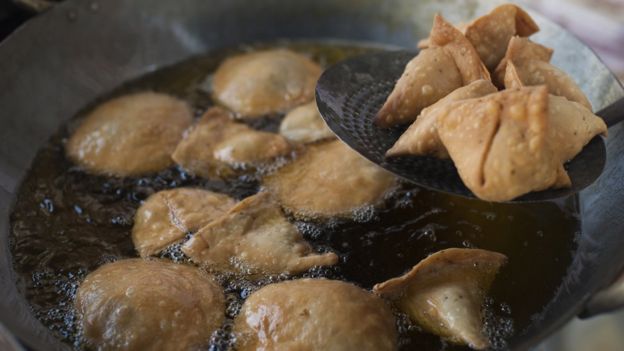サモサの話。
本日の軽食は息子→チキンマックナゲット、父→サモサ
そんな休日です(笑)
近所のフードコートのインドカレーのお店。
ここで、初めてサモサをオーダーしたけど
カレーよりも旨いなぁー(笑)ま、輸入冷凍ものだと思うけど。
今日は別の記事をアップしようかと思ってたけど
サモサを調べてたら、
以下のブログで見たサモサの話が面白かったので
こちらをアップしてみまーーす。
包んで揚げる餃子っぽさから中国ルーツと勘違いしがちですが
ルーツはペルシャってのは覚えておきたいところですね!!
スパイシ~~♪♪♪
・・・・・・・・・・・・・・・・・・・・・・・・・・・・・・・・・・・・・・・・・・・・・・・・・・・・・・・・・・・・・
http://asksiddhi.in/blog/display/401
サモサの歴史とその広がり:BBC記事より
食のグローバル化によって、様々な国の料理をどこにいても食べられるようになった現代。
中でもインドの大衆スナックの代表、サモサは、インド料理店では必ず定番メニューに登場する。
パリパリの皮を頬張ると、茹でてつぶし、スパイスやハーブで味付けしたジャガイモの、柔らかな口当たりを楽しめ、誰もが愛するサモサ。
BBCの記事によれば(http://www.bbc.com/news/magazine-36548445)
このシンプルなスナックは意外に歴史が深く、しかも数カ国にもまたがる広く長い旅をしてきたことが分かっている。
サモサの起源はイラン高原にあるとされ、ペルシア語で三角形を意味する「サンボサグ(Sanbosag)」という宮廷料理が語源であるというのが通説だ。
古くは紀元11世紀のペルシア人歴史家(Abul-Fazl Beyhaqi)の手による文献に登場、挽き肉やナッツ、ドライフルーツなど贅沢な食材を使用したサンボサグが、後に「パールシー(Parsi)」と呼ばれることになるインドへの移住者をはじめ、世界各地に広まっていった。
Wikipediaを見てみると、その後インドだけでなく、遠くは南アフリカの最南端にまでも広まっていったようだ。
サモサがインドに到達すると、宮廷料理としての高級感よりも、菜食主義者でも手軽に食べられるスナックとしての性格が色濃くなり、ジャガイモをベースに、コリアンダー、コショウ、キャラウェイシード、ショウガなどの各種スパイスを組み合わせた世界初のファーストフードとなっていった。
16世紀にポルトガル人の貿易業者らがインドに進出すると、「新世界」からもたらされた食材で味付けされ、一層豊かに進化し続けていった。
詳細な歴史的、文化的な背景や現代のサモサ事情についてはBBCの元記事に譲るとして、サモサを食べたくなった。
日本では、一部のカレー店やインド料理店で春巻きの皮を使ったサモサが登場する。
これもまたひとつのサモサと言えるかもしれない。
・・・・・・・・・・・・・・・・・・・・・・・・・・・・・・・・・・・・・・・・・・・・・・・・・・・・・・・・・・・・・
英語が得意な方はBBCの記事もあわせてぜひ。
The story of India as told by a humble street snack
By Justin RowlattSouth Asia correspondent
http://www.bbc.com/news/magazine-36548445
You may think of the samosa as a humble street snack but it is much, much more than that.
It is an historic artefact - as well as delectable evidence that there is nothing new about the process of globalisation.
Bite into a samosa and the notion that identity is defined by the boundaries of a nation state should shatter like the deep-fried crust.
These days it is considered a quintessentially Indian delicacy, but its history is far more complex and cosmopolitan than that.
Savour the sensation as your teeth sink into the soft, yielding centre. Let the flavours flow into your mouth.
What you are tasting is the story of India itself - the product of the fluid forces of the great migrations and interactions that shaped this country.
 Image copyrightGETTY IMAGES
Image copyrightGETTY IMAGESThe samosa's origins actually lie thousands of miles away in the ancient empires that rose up in the Iranian plateau at the dawn of civilization itself.
We don't know for certain when the first cooks shaped pastry into the now-familiar triangular shape but we do know that the origins of the name are Persian - "sanbosag".
The samosa is first mentioned in literature by the Persian historian Abul-Fazl Beyhaqi, writing in the 11th Century.
He describes a dainty delicacy, served as a snack in the great courts of the mighty Ghaznavid empire. The fine pastry was filled with minced meats, nuts and dried fruit and then fried till the pastry was crisp.
But the samosa was to be transformed as it followed the epic journey made by successive waves of migrants into India.
It was brought to India along the route the Aryans had taken more than 2,000 years earlier - through Central Asia and then over the great mountains in what is now Afghanistan, before descending down into the fertile plains of the great rivers of India.
 Image copyrightKIRTISH BHATT
Image copyrightKIRTISH BHATTThis is the third article in a BBC series India on a plate, on the diversity and vibrancy of Indian food. Other stories in the series:
Why India is a nation of foodies
Cooking the world's oldest-known curry
The great armies of the Mamluks, Tamerlane and the Mughals later made the same journey, helping build the great sub-continental empire we now know as India.
And, just as India was reshaped by these waves of migrants, the samosa also underwent a transformation.
Initially it metamorphosed into something much less refined.
By the time it reached what is now Tajikistan and Uzbekistan it had become what Professor Pushpesh Pant, one of the world's experts on Indian food, describes as "a crude peasant dish".
Out of media player. Press enter to return or tab to continue.
The courtly titbit was now a high-calorie staple, a much bigger and heartier dish - the sort of thing a shepherd would take out into the pastures with him.
It retained its distinctive shape and was still fried, but the exotic nuts and fruits were gone - the savoury pastry was now filled with coarsely chopped goat or lamb eked out with onions and flavoured simply with salt.
Over the following centuries the samosa made its way over the icy passes of the Hindu Kush and into the Indian subcontinent.
What happened along the way explains why Professor Pant regards the samosa as the ultimate "syncretic dish" - the ultimate fusion of cultures.
 Image copyrightGETTY IMAGES
Image copyrightGETTY IMAGES
"I think the samosa tells you how influences, culinary and otherwise, have come across to us," he says, "and how India has adopted them, adapted them to its own requirements and milieu, and transformed them totally."
Once in India the samosa was taken up and tailored to local tastes, becoming the world's first fast food.
The samosa is endlessly adaptable and India introduced its own spices - adding coriander, pepper, caraway seeds, ginger and more.
The filling changed, too, with vegetables often replacing meat.
Later still it was to become the vehicle for other much more novel foodstuffs, because the modern Indian samosa is the product of yet another great historical upheaval - the discovery of the New World.
These days most samosas are filled with potato and flavoured with green chillies, ingredients only introduced from the New World by Portuguese traders in the 16th Century.
And the samosa has continued to evolve since then.
Everywhere you go in India it is different.
 Image copyrightGETTY IMAGES
Image copyrightGETTY IMAGESSamosas vary from region to region, and even from shop to shop as samosa-makers compete for custom.
Sometimes they are monsters, an entire meal in a single crisp pastry casing.
Elsewhere they have re-emerged as a courtly treat - samosas are served as cocktail canapés at weddings and modish Delhi parties.
Even the wafer-thin pastry packed with mince and peas that the Moroccan traveller Ibn Batuta describes being served at the lavish banquets of the court of Mohammad bin Tughlaq in 14th Century Delhi, lives on in the "lukhmi" of Hyderabad.
Meanwhile in Punjab no samosa is complete without the addition of paneer - fresh Indian cheese - though elsewhere in India this is considered an aberration.
Not all samosas are savoury these days - at least one Delhi restaurant serves a delicious chocolate samosa.
And even the cooking techniques can vary.
The classic samosa is still fried to a crisp, golden finish, but you can sometimes find baked samosas for the calorie-conscious.
Some chefs have experimented with steamed samosas - a mistake, says Professor Pant. He argues that without the oil the flavours simply don't emerge properly.
And, of course, the samosa's journey did not end in India. After centuries of refinement and reworking here it followed new routes back out into the world.
 Image copyrightGETTY IMAGES
Image copyrightGETTY IMAGES
The British loved the samosa and spread the now uniquely Indian innovation across their vast empire - along with shampoo, bungalows, verandas and pyjamas.
And, as the Indian diaspora has spread around the globe in the last few centuries, they too took samosas with them.
Which is why what began as a tasty titbit for ancient Persian emperors is now enjoyed in virtually every country on Earth.
So as you savour this delicious snack remember this, wherever your samosa was prepared and however it was filled it embodies the essence of India - adaptable, inventive, tolerant and heterogeneous.
And many of the country's other delicious street foods have similarly fascinating stories.
As the BBC's South Asia correspondent I have the privilege to travel across India and as I go I intend to explore the incredible culinary history of this great nation through its street food.
So if there are any street foods that particularly tickle your palate - or you think will tickle mine - do please contact me and tell me what they are and where the best examples can be found and I'll do my best to get out there and taste them.
・・・・・・・・・・・・・・・・・・・・・・・・・・・・・・・・・・・・・・・・・・・・・・・・・・・・・・・・・・・
スパイシーさんの公式facebookページもチェケラしてみよう!!
ページ上部中央にある『いいね』ボタンをクリックしてくれると嬉しいでスパイシ~~♪♪♪
http://www.facebook.com/spicymaruyama
※スパイシー丸山への問い合わせはfacebookページのメッセージ欄へ。
初著書「初めての東京スパイスカレーガイド」絶賛発売中(送料無料)!!
Amazon→http://www.amazon.co.jp/初めての東京スパイスカレーガイド-スパイシー丸山/dp/4865810226
楽天ブックス→http://books.rakuten.co.jp/rb/13315762/
インド料理店、南アジア料理店の店主にお話しを聞く、好評のインタビュープロジェクト「Diggin'」はこちら→http://blog.livedoor.jp/kiyotoku_sauceco-spicymaruyama/
旨辛調味料ソースコとスパイシーさんのコラボレシピサイト「Wild Spice」でカレーレシピをアップしていまーす!!http://kiyotoku.co.jp/ws/
この夏、スパイシーさんも監修に参加したカルビーのポテトチップス「カレーマニア」が期間限定で発売となりました。http://s.ameblo.jp/maruyamashu/entry-12179429156.html
朝日放送・探偵ナイトスクープに出演!カレーの隠し味の秘密に迫りました。http://s.ameblo.jp/maruyamashu/entry-12104741017.html
NHK・マサカメTVに出演!和の食材だけで作る和のグリーンカレーを考案しました。http://s.ameblo.jp/maruyamashu/entry-12121689378.html
日テレZIP!に出演!新カレーメニューを提案しました。http://ameblo.jp/maruyamashu/entry-12033634887.html
TBSアッコにおまかせ!に出演!行列の出来るお店を紹介しました。http://ameblo.jp/maruyamashu/entry-12049884389.html
MBS「明石家電視台」で明石家さんまさんと奇跡の共演を果たしました!
http://s.ameblo.jp/maruyamashu/entry-11941078236.html
CBCゴゴスマに出演!華麗なるカレーの世界を案内しました。http://s.ameblo.jp/maruyamashu/entry-12104743537.html
「WOWOWぷらすと」アーカイブ版。「カレーはエンターテイメント」をテーマに語り尽くす90分!http://st.wowow.co.jp/detail/7124?utm_source=twitter_plast&utm_medium=social&utm_campaign=wryu_2015
J-WAVE「Hello World」に出演。アーカイブをYouTubeで見ることができまーす!!
https://www.youtube.com/watch?v=RL3Ok05-tlM&feature
石田純一さんとガチ実食!カレーパンについて熱く語っていまーす。
http://lifemagazine.yahoo.co.jp/articles/53
オリコンの女性向けサイトelthaにスパイシーさん登場!「美とスタミナをチャージ!カラダ喜ぶ夏カレー」をテーマにカレーの魅力&レシピを紹介しています。http://beauty.oricon.co.jp/life-style/recipe/special/100195/
これがベストだ!スパイシー丸山が選ぶカレー店とレトルトカレー。
http://www.webdice.jp/dice/detail/4456/


